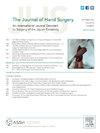关节内桡骨远端骨折沃尔钢板固定中螺钉长度的影响:生物力学研究
IF 2.1
2区 医学
Q2 ORTHOPEDICS
引用次数: 0
摘要
目的:本研究的目的是在尸体模型中比较不同螺钉长度对粉碎性关节内桡骨远端骨折固定后失败载荷和尺骨背角碎片保留的影响:对 24 具新鲜冷冻的尸体前臂进行标准化桡骨远端截骨,以模拟关节内骨折模式。进行双 X 射线吸收扫描以确保骨密度变化最小。所有骨折均使用外侧锁定钢板和远端锁定螺钉固定。每组八个样本中使用了三种不同长度的远端锁定螺钉,以模拟不同远端螺钉长度的临床决定。测试的螺钉长度分别为双皮质、100% 骨宽但单皮质以及 75% 骨宽但单皮质。所有试样均以循环轴向加载进行预处理,然后使用匹配的丙烯酸树脂模具进行轴向加载,以达到临床失效和运动分析系统检测到的片段位移。加载过程中尺侧背角碎片的保留或脱落被记录为二元变量:三组之间在循环前刚度、循环后刚度、尺骨背角位移 2 毫米时的载荷或失效时的力方面没有统计学意义上的显著差异。与其他组(0%)相比,使用 75% 长度螺钉组的尺骨背角缩减率(86%)明显更高:结论:不同的螺钉长度不会影响轴向加载试样的刚度或失效时的总载荷。然而,长度为 75% 的螺钉并不能可靠地固定背侧尺骨角碎片。虽然这对结构的整体破坏载荷没有明显影响,但该片段的移位可能会影响前臂通过桡骨远端关节的旋转:外科医生应考虑使用全长单皮质锁定螺钉,以确保充分固定尺骨背角:生物力学研究本文章由计算机程序翻译,如有差异,请以英文原文为准。
Effect of Screw Length in Volar Plating for Intra-Articular Distal Radius Fractures: A Biomechanical Study
Purpose
The purpose of this study was to compare the effect of varying screw lengths on load to failure and retention of the dorsal ulnar corner fragment after fixation of comminuted intra-articular distal radius fractures in a cadaveric model.
Methods
Twenty-four fresh frozen cadaveric forearms were subjected to a standardized distal radius osteotomy to mimic an intra-articular fracture pattern. Dual X-ray absorptiometry scans were performed to ensure minimal variability in bone density. All fractures were fixed with a volar locking plate and distal locking screws. Three different lengths of distal locking screws were used in each group of eight specimens to simulate the clinical decision of different distal screw lengths. The screw lengths tested were bicortical, 100% of the width of the bone but unicortical, and 75% of the width of the bone and unicortical. All specimens were preconditioned with cyclic axial loading and then axially loaded using matching acrylic resin molds to clinical failure and fragment displacement as detected by a motion analysis system. Retention or loss of the dorsal ulnar corner fragment during loading was recorded as a binary variable.
Results
Between the three groups, there were no statistically significant differences in precycling stiffness, postcycling stiffness, load at 2 mm displacement of the dorsal ulnar corner, or force at failure. The group with 75% length screws had a significantly higher loss of reduction of the dorsal ulnar corner (86%) compared with the other groups (0%).
Conclusions
Varying screw lengths did not affect the stiffness or overall loads to failure of axially loaded specimens. However, the 75% length screws did not reliably secure the dorsal ulnar corner fragments. Although this did not significantly affect the overall load to failure of the construct, displacement of this fragment may have implications for rotation of the forearm through the distal radioulnar joint.
Clinical relevance
Surgeons should consider the utilization of full-length unicortical locking screws to ensure adequate fixation of the dorsal ulnar corner.
求助全文
通过发布文献求助,成功后即可免费获取论文全文。
去求助
来源期刊
CiteScore
3.20
自引率
10.50%
发文量
402
审稿时长
12 weeks
期刊介绍:
The Journal of Hand Surgery publishes original, peer-reviewed articles related to the pathophysiology, diagnosis, and treatment of diseases and conditions of the upper extremity; these include both clinical and basic science studies, along with case reports. Special features include Review Articles (including Current Concepts and The Hand Surgery Landscape), Reviews of Books and Media, and Letters to the Editor.

 求助内容:
求助内容: 应助结果提醒方式:
应助结果提醒方式:


